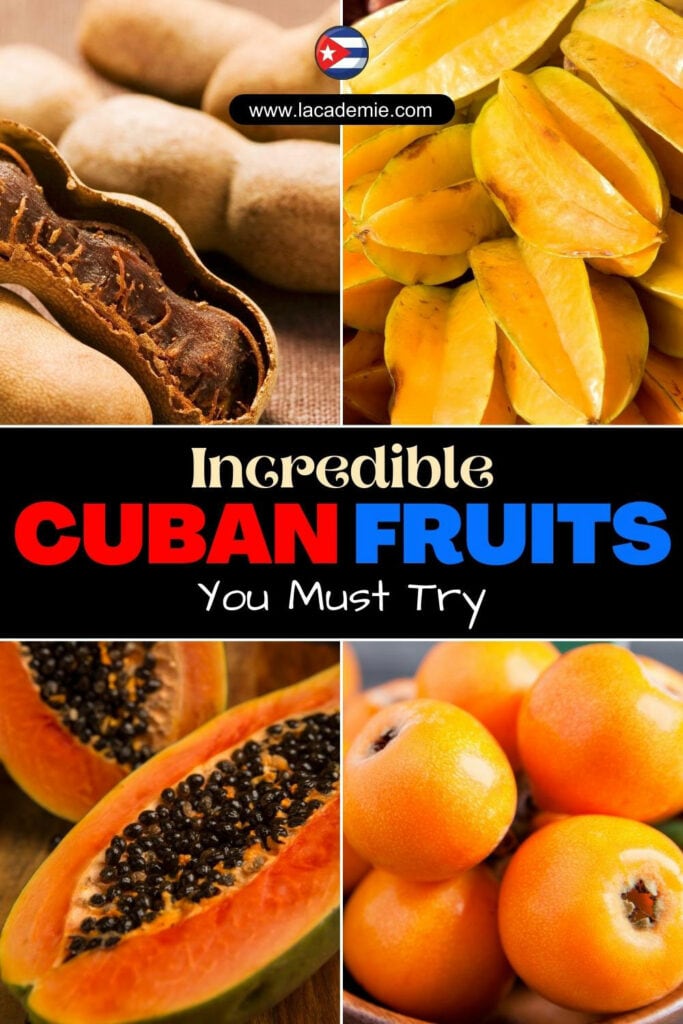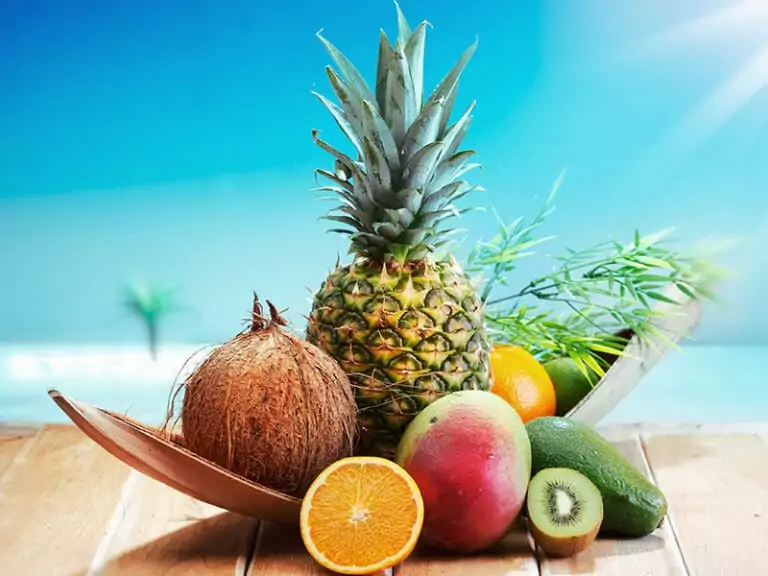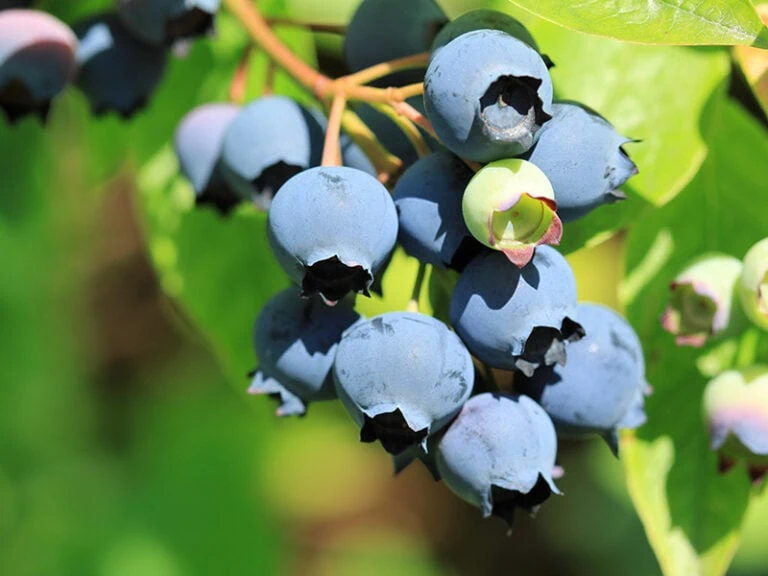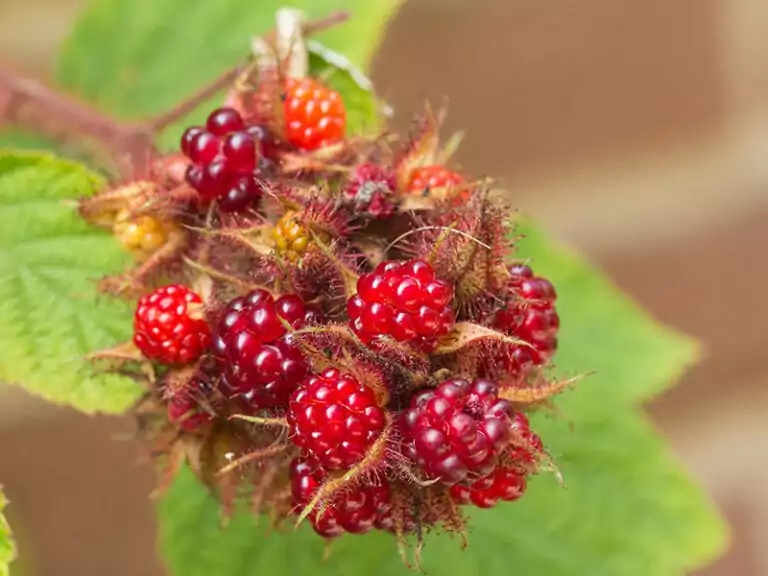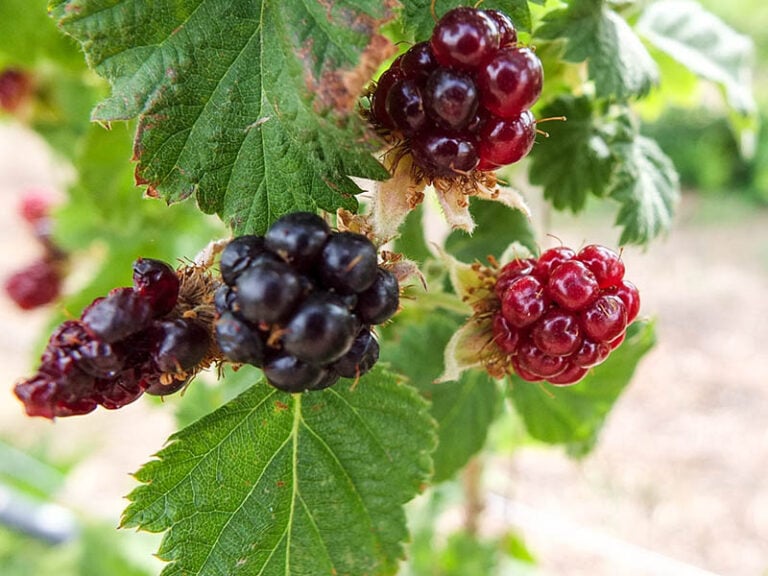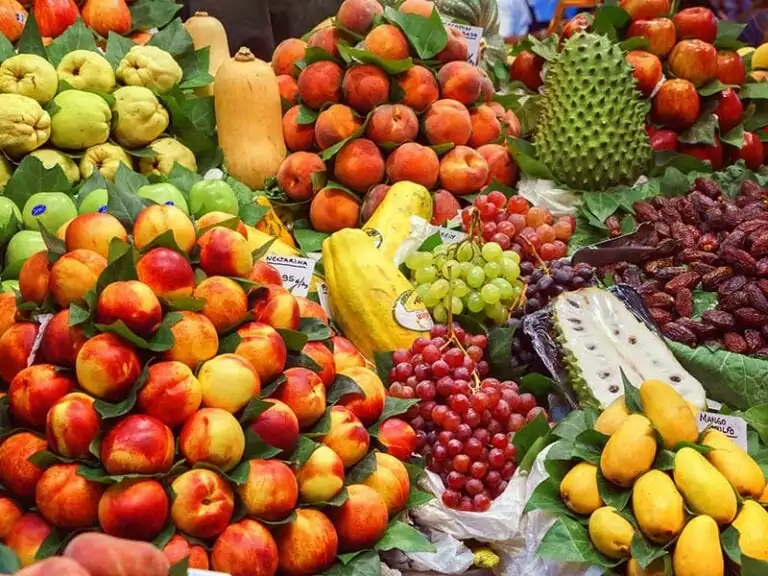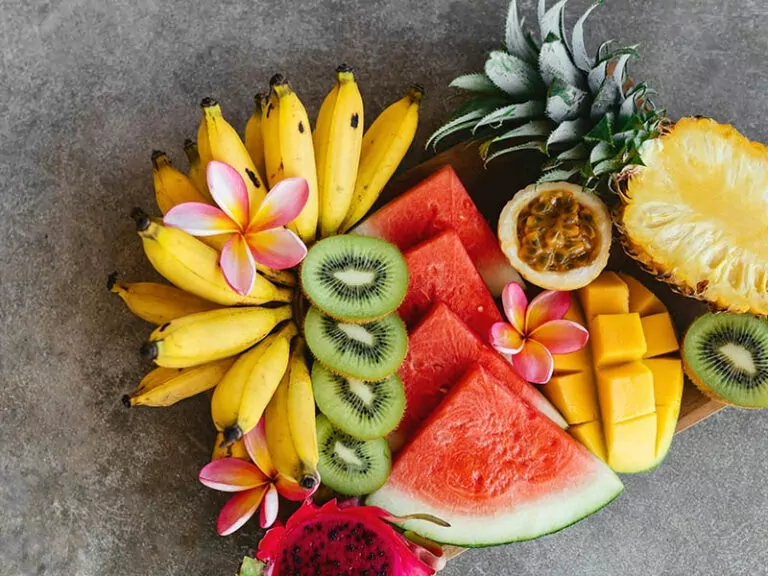Until now, I cannot forget the outstanding and excellent taste of Cuban fruits I have tried on my last trip. The preparation for your trip to Cuba will become easier after reading this fantastic article.
In this article, I provide all the essential information about the fresh treats in Cuba. Your job is to follow the post carefully and note your favorite fruits. I hope this post will be valuable to you and bring a good trip for you.
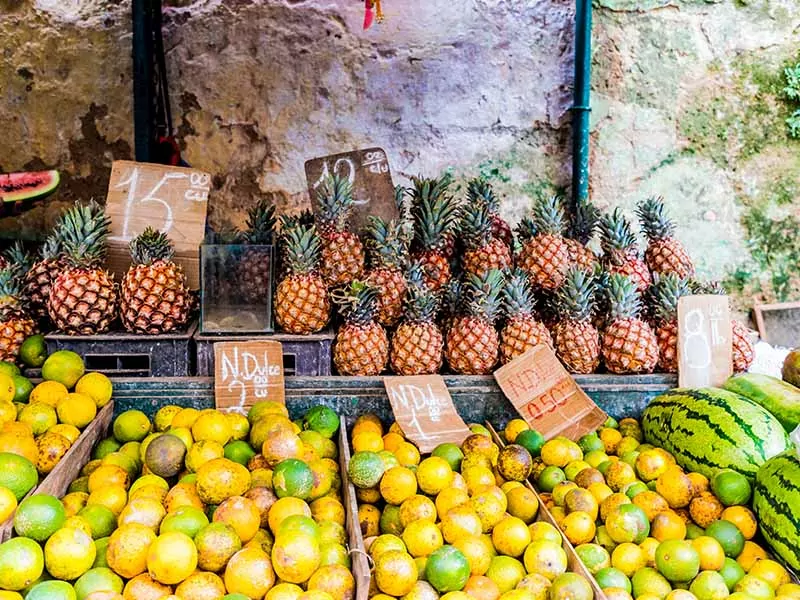
5 Excellent Cuban Fruits Containing One Seed
In the first section, I will give you a list of delicious Cuban fruit containing only one seed in the middle. Do not forget to remove the stone from these fruits before eating.
1. Guinep – Mamoncillo
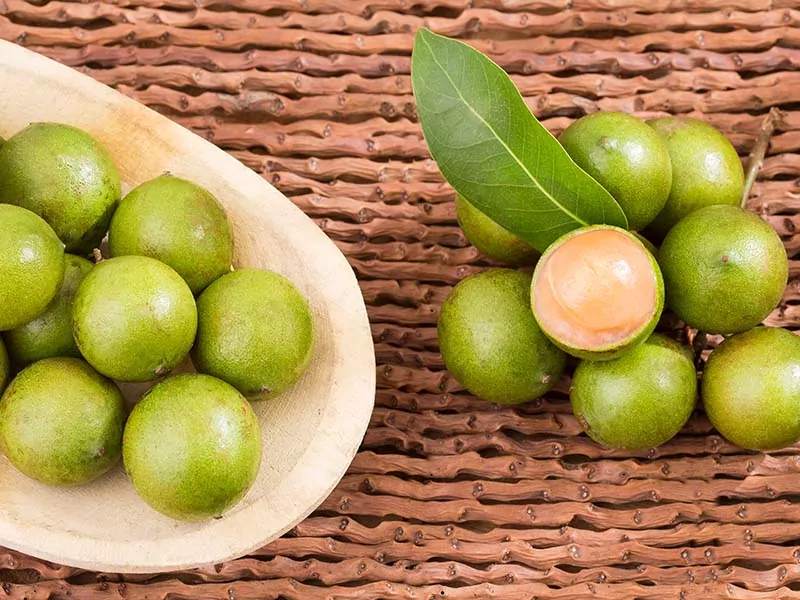
If you want to consume inexpensive and yummy Cuban fruit, guinep or mamoncillo is an excellent suggestion. In English, people often call them Spanish limes. In addition, it has many other names, including mamon, limoncello, guaya, and quenapa.
The appearance of this fruit has many similarities with lychee. Many mamoncillos attach in bunches. This fruit is native to Central America, the Caribbean, and South America, so many natives and tourists in Cuba love it.
You will fall in love with the delicious drupe fruit right away. At first sight, the round shape and the glossy green peel will captivate you immediately. After breaking the peel, you can suck the orange and juicy pulp inside.
The pulp will cover the whitish seed in the center. And remember to get rid of the seed while consuming. This fruit has a mild flavor with a sweet taste and light bitterness. This taste can remind me of the flavor of the wine.
It is a delicious option for your party in the summer. You can consume fresh mamoncillo or choose the canned version to enjoy. Many yummy Cuban drinks contain this fruit, such as soft drinks, cocktails, and alcoholic beverages.
Nutrients: Rich in carbs, calories, fiber, calcium, phosphorus, and vitamin C.
Season: July to August is the best moment for picking mamoncillo in Cuba.
How to eat: Break the fruit’s skin and pop it in your mouth. Suck the flesh and remove the seed white eating it.
2. Plum – Ciruela
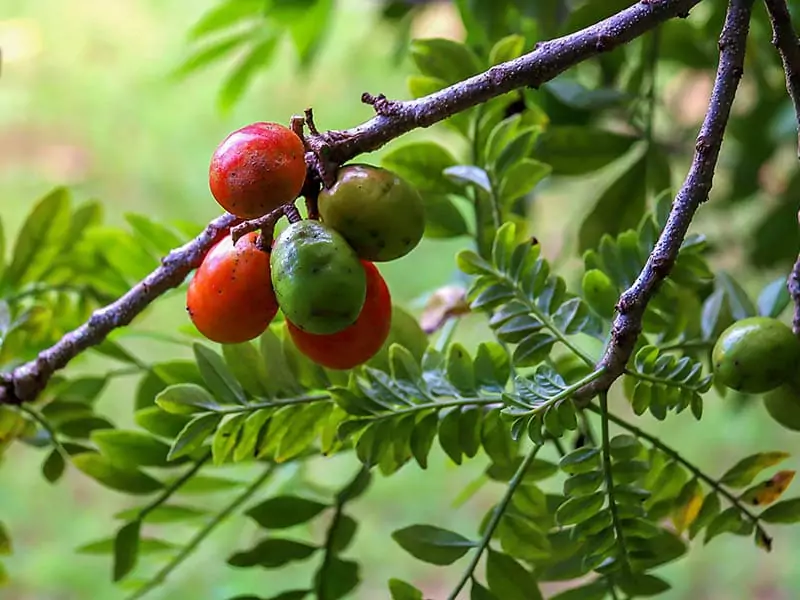
Ciruela is a part of the Anacardiaceae family I want to introduce to you in this article. People in Central America have cultivated and used this fruit for thousands of years. This fruit is famous in Mexico, Brazil, Cuba, and the Caribbean countries.
Jocote is another name for this fruit. This name comes from the “xocotl” world, which means acidic fruit in Nahuatl. You can consume the waxy and green skin of this fruit. The flesh will have an eye-catching yellow hue and sweet taste when ripe.
There are various kinds of plum with various textures. Typically, this fruit will make you flutter with its crunchy texture. You can feel the acidic aftertaste while eating ciruela. You should remove the inedible and large stone in the middle of the fruit.
After holidays, people often consume this fruit to treat indigestion or stomach upset in Cuba. If you walk on the streets in Cuba, you should try the snack with fresh ciruela and salt or pepper. In addition, it is suitable for making jams or syrups.
Nutrients: Rich in calories, carbs, vitamin A, C, K, and potassium.
Season: Its season extends from May to June in Cuba.
How to eat: Peel the rind of the plum and consume the flesh around the pit. Or you can cut the meat from the seed to eat.
Go to the garden to take a closer look at delicious plums right now.
3. Avocado – Aguacate
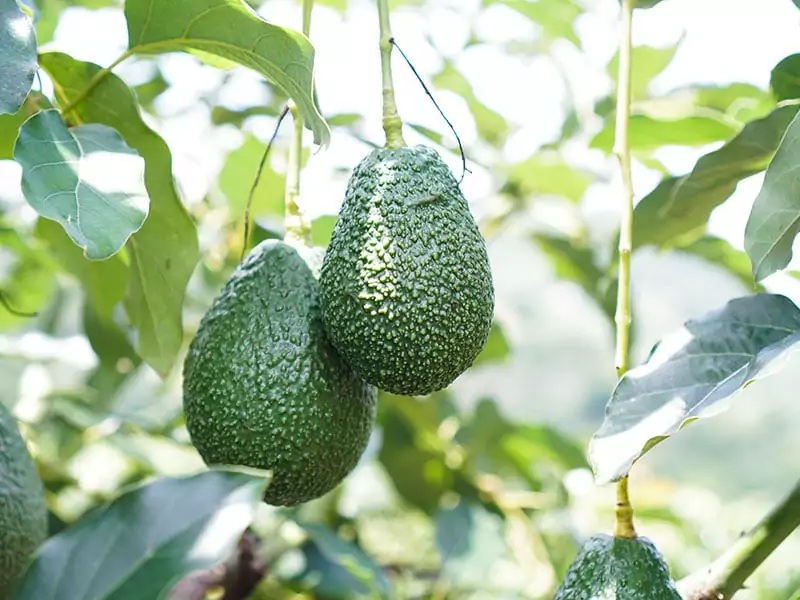
When coming to Cuba, you will have the chance to try many delicious Cuban side dishes containing avocados, such as salads or sauces. Most tourists do not want to miss Cuban avocado because of the fantastic flavor and texture.
This fruit is well-known in America since this continent is the homeland of avocado. Especially south-central Mexico and Guatemala have the most avocado quantity in America. This fruit is an essential part of the Lauraceae family.
It is a large berry with a large seed in the middle. Cuba has many different types of avocados with various colors and shapes. Usually, the buttery flesh will be protected by the brown, green, purple, or black peel.
The mild and delicate taste of avocado will make you remember it forever. When biting avocado, the typical earthy and grass taste are the first things you feel from this fruit. In addition, a note of nutty flavor will make it better.
You can combine avocado with sugar and milk to make fresh and mouthwatering smoothies. People also add it to ice cream or cake to take advantage of its buttery texture. Also, it appears in salads and many other sweet and savory dishes.
Nutrients: Fiber, healthy fats, vitamin C, B6, E, magnesium, folate, and potassium.
Season: The season of avocado runs from July to September in Cuba.
How to eat: The fastest way to eat avocado is to cut it into 2 parts, remove the seed and get the flesh with a spoon.
4. Mango
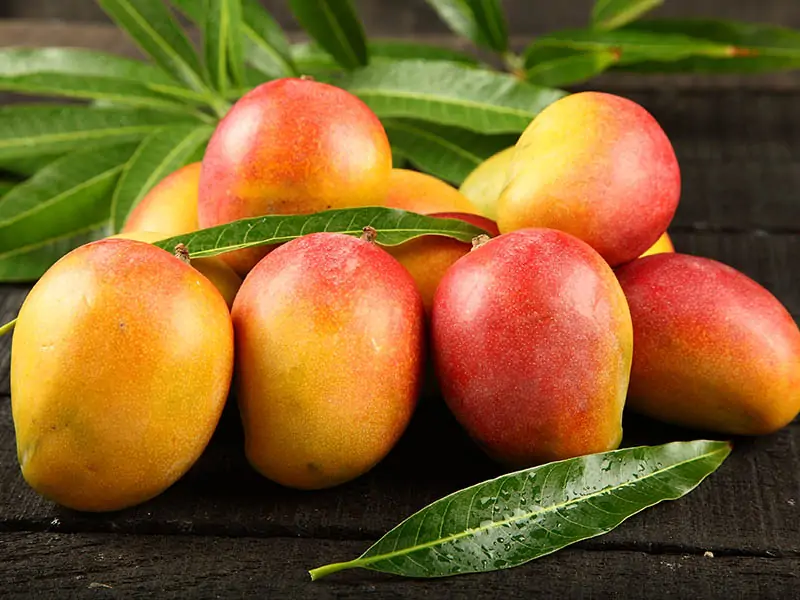
Mango is the next suggestion I want to show in this list. You can buy mangoes at any supermarket in many parts of the world. This yummy fruit is native to Myanmar, India, and Bangladesh. Indian and Southeast Asian mangoes are the 2 main types of this fruit.
Mango is diverse in shape with kidney, round, or oval. It is green in color when immature, and the crunchy texture is suitable for making salads. It turns yellow, red, or orange when mature. The charming aroma of mango will conquer you right away.
Cuba has many excellent cultivars of mango, including mango manzano, mango reina, seniora mango, yellow ataulfo mango, mango compota, and mango biscochelo. They are grown across the country.
You can think of the taste of limes when enjoying unripe mangoes. However, the ripe version will be softer, creamier, and sweeter. Besides, sourness is an indispensable flavor of every type of mango.
Mango is added to many cuisine recipes. You will find the crunchiness and sourness of unripe mango in chutneys, pickles, drinks, jellies, and daals. Juices, curries, and smoothies are the common foods made from ripe mangoes.
Nutrients: Plenty of calories, fiber, vitamin C, A, and potassium.
Season: May to September is an ideal time for ripe mangoes.
How to eat: You can peel the skin and consume around the pit. In addition, it is acceptable to slice around the seed and devour the flesh from the rind.
5. Mamey
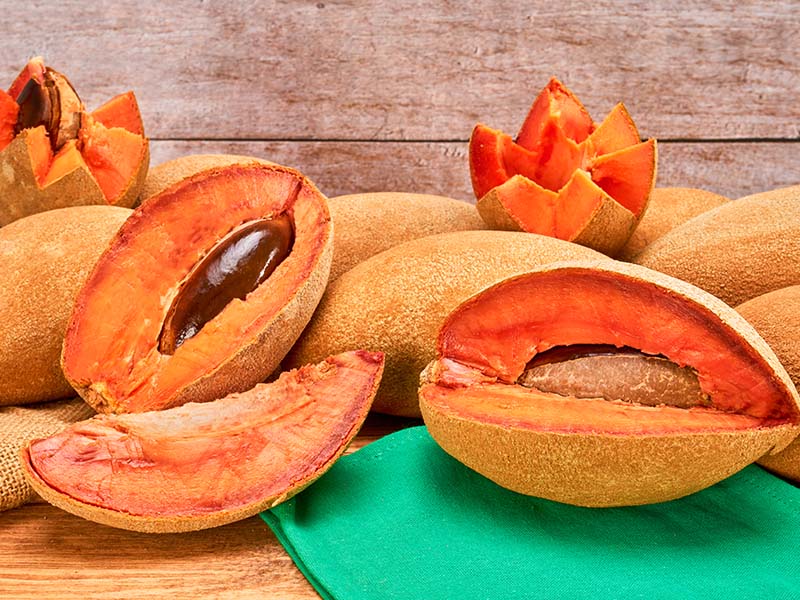
Mamey is a national fruit of Cuba. Besides this name, it is also known as Sapote. This delicious fruit has its origin in Mexico and Central America. Furthermore, it is grown abundantly in the Caribbean and Latin America.
Mamay is an excellent berry with a characteristic brown skin. When you touch its skin, you can imagine the texture of sandpaper. Pink, red, and orange are the standard colors of its flesh. Significantly, the soft and creamy texture of mamey will fascinate you.
The flavor of mamey fruit is complex because it combines the taste of sweet potato, honey, pumpkin, almond, and cherries. Cubans always express their excitement in the mamey season because they will have the opportunity to enjoy fresh and fried versions.
Extraordinary Cuban desserts are made from this fruit, such as milkshakes, ice cream, fruit bars, and marmalade. Its seeds are the perfect element for making Sapayul oil.
Nutrients: High in calories, protein, carbs, fiber, and fat.
Season: Its season is in winter, so you can find this fruit from December to February or even March.
How to eat: Slice this fruit into 2 halves, remove the pit and consume its pulp with a spoon.
Learn the proper ways to consume mamey immediately.
15 Mouthwatering Cuban Fruit With Many Seeds
Along with the fruit containing a single seed, you are able to refer to the outstanding fruit, including many seeds. The seeds can be edible or inedible, so you can follow the information below to get the right ways to eat them.
6. Guava – Guayaba
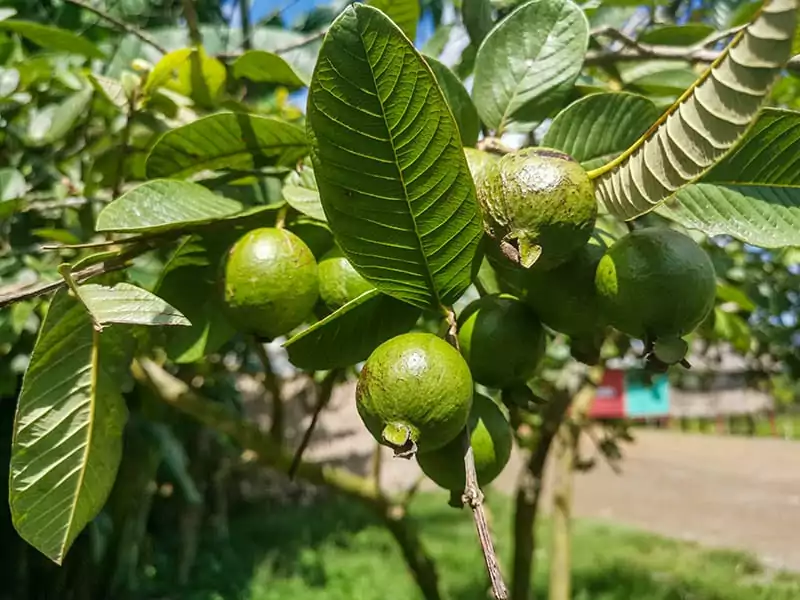
Guava is one of the famous Cuban fruits you should not ignore. Also, this fruit is a widespread Peruvian fruit. It has become an essential ingredient in many yummy Cuban desserts, such as ice cream, jams, juices, and smoothies in Cuba.
This fruit comes from Mexico, the Caribbean, Central America, and South America in terms of origin. It has become a global fruit since you can find it easily in many tropical and subtropical countries worldwide.
Besides the typical round shape, you can see guava in an oval shape. There are a lot of sorts of guava, so it is diverse in colors, shape, sizes, and flavors. Usually, unripe guava will be green in color and crunchy in texture.
It is safe to consume the rind, but it can be sweet or bitter. Guava often appears in yellow, maroon, or even green when ripe. The eye-catching deep pink, red, or white flesh will make you want to try it right away.
It contains numerous tiny seeds inside. You will love the delicate and enchanting sweet taste of this guava. Moreover, your palate will be tickled by the slight sourness. If you want to get the sweeter taste, you should choose the ripper guava.
In Cuba, guava is often used to make jam, ice cream, smoothies, cheese, and many other desserts. In addition, you can feel the authentic flavor of guava when you consume the fresh one.
Nutrients: A source of calories, carbs, fiber, protein, vitamin C, and potassium.
Season: Its season runs from November to April in Cuba.
How to eat: Peel the skin of guava. Use a knife to cut it into small pieces to eat.
7. Papaya – Frutabomba
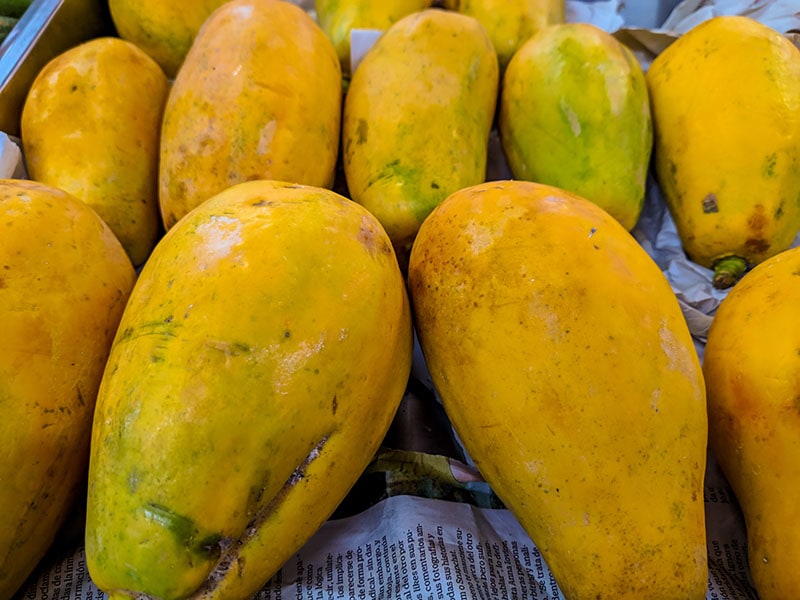
It is hard to resist the smooth and creamy texture of frutabomba or papaya. Thanks to the outstanding advantages, this fruit appears commonly in many delicious Cuban foods. In particular, Cubans can laugh at you if you call them papaya. So, let’s just call it frutabomba.
Papaya is a member of the Caricaceae family, and it is cultivated for the first time in Central America and southern Mexico. Frutabomba is a berry with the typical elongated or oval shapes. Green frutabomba is suitable for cooking due to its crunchy texture and a mild taste.
The skin will turn from green to yellow or orange when ripe. Simultaneously, its texture will become softer and creamier. The charming aroma of orange, red, or yellow flesh will conquer you right away.
In the central cavity of this fruit, you can find countless inedible and bitter seeds. It has a lightly sweet taste, and the flavor resembles mango and cantaloupe melons.
The buttery flesh will make the smoothies, pies, and baked goods better. Papaya pie is famous in restaurants in Havana. You can enjoy salads and frutabomba for breakfast with banana and pineapple.
Nutrients: Plenty of calories, carbs, fiber, vitamin C, A, folate, and potassium.
Season: This fruit is available all year round, but this country’s peak season runs from spring to autumn.
How to eat: Dice papaya into 2 parts and get rid of the seeds inside. Use a spoon to get the flesh to eat.
Follow these instructions to make delicious Dulce de Papaya.
8. Soursop – Guanabana
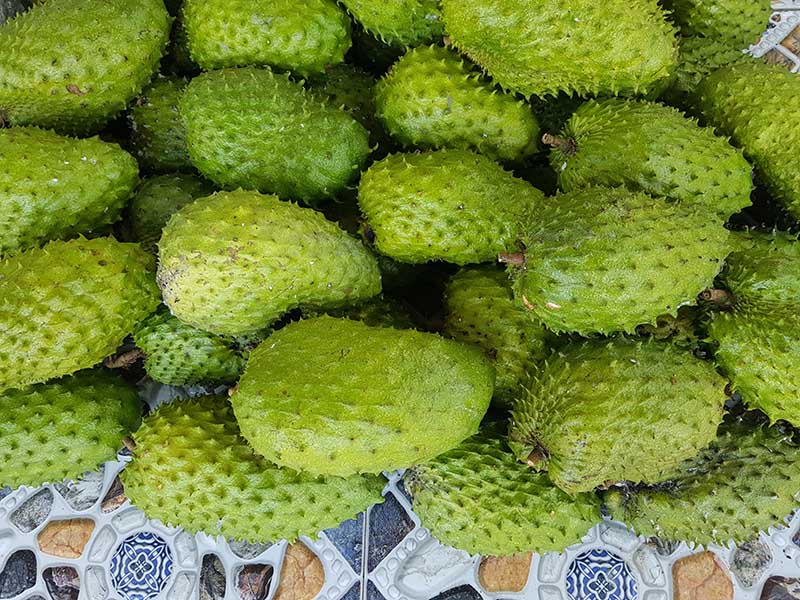
Guanabana is also known as soursop in English. In addition, it is called Guyabano or Graviola in many other regions globally. Almost all Cubans and tourists love to try this fruit and the excellent recipes made from guanabana.
This fruit is native to the Americas, the Caribbean, and other tropical regions. The environment with high humidity is suitable for the growth of this fantastic fruit. Guanabana looks prominent in the deep green and prickly skin.
However, guanabana’s aromatic and whitish flesh will make you fall in love. Your mouth will be exposed to sweet, juicy, and acidic flesh. The soft and creamy pulp will melt gradually in your mouth.
It is easy to find this fruit at the local markets or vendors on the street in Cuba. It is said that this fruit can treat cancer thanks to its antioxidant and phytochemical properties. However, it is just a rumor, and there is no scientific proof of the information.
Cubans love to use guanabana in smoothies, drinks, candies, sorbets, and ice cream. In particular, consuming raw guanabana is an exciting experience you should try.
Nutrients: Rich in calories, protein, carbs, fiber, and vitamin C.
Season: You can buy it all year round, but its peak season lasts from July to August and February to June.
How to eat: Cut the fruit into 2 sections and eat the flesh with a spoon. Remember to remove the seeds while consuming.
9. Loquat – Nispero
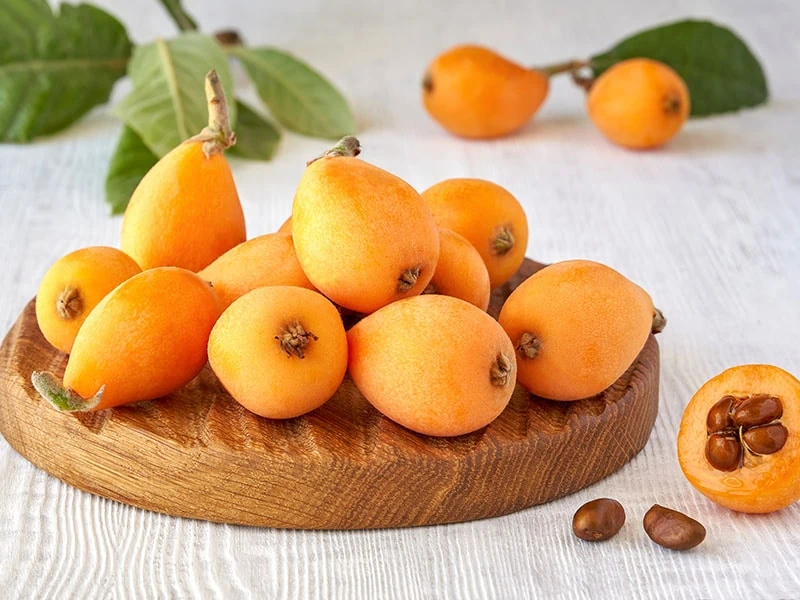
Cuba has many delicious fruit species, and nispero or loquat is one of them. It belongs to the Rosaceae family and originates in the hill regions of China. Gradually, this fruit spreads to Cuba, Central America, Japan, and many European countries.
Its shape is similar to a pear, and you can come across it in oval or round shapes. You will be captivated by the smooth and downy texture of the yellow, red, or orange skin. Beneath the skin, you will find a layer of white, yellow, or orange flesh and some seeds.
This fruit has a distinctive flavor, and its taste can steal your soul right away. The sweet taste is the main feature of loquat. In addition, you can feel a light tartness and a hint of citrus fruit taste from this fruit. People often eat it raw or make jam from loquat.
Nutrients: It includes calories, carbs, fiber, vitamin A, B6, folate, and magnesium.
Season: It is often ripe from May to June in Cuba.
How to eat: Break the fruit and remove its inedible seeds. Take a small spoon to scoop the flesh.
Discover the methods you can use loquat in cuisine.
10. Tamarind – Tamarindo
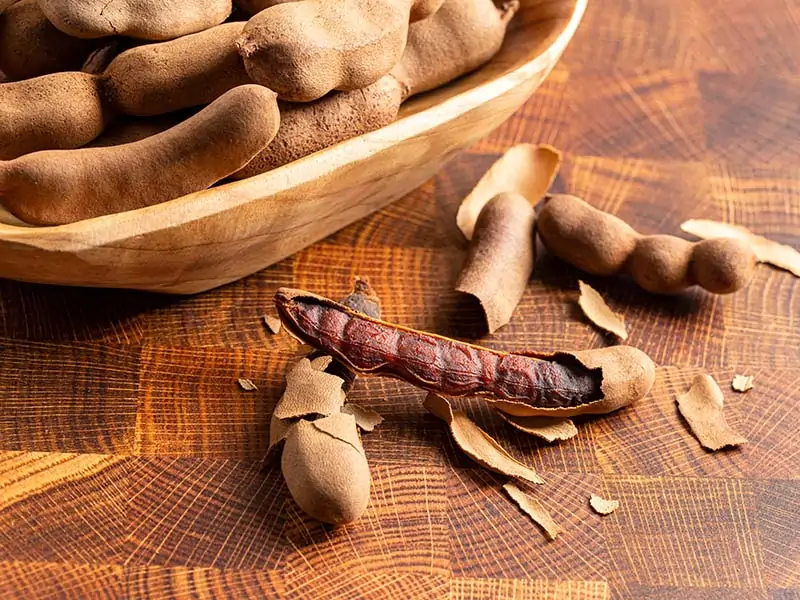
If you are a big fan of sour-sweet fruit, tamarind is ideal. You have to give it a shot when traveling to Cuba. This fruit is common at the Havana beaches, and you should try the dessert recipe with tamarind jammy balls tossed in sugar.
Although this famous fruit is derived from Africa, it is loved in Cuba and other regions worldwide. Spanish and Portuguese colonists brought this fruit to Central America in the 16th century.
This fruit grows in length and is protected in a pod. When you see brown or reddish-brown shades of its pulp, this is a sign of mature tamarind. Each tamarind contains about 6 to 12 seeds covered by juicy and sour pulp.
Moreover, the ripe tamarind tastes sweet mildly. This fruit is a tartaric acid, vitamin C, and calcium source. People will create a paste from tamarind to use in cooking. Mainly, you can find it in the famous Worcestershire sauce.
Nutrients: It consists of calories, carbs, fiber, vitamin C, potassium, and magnesium.
Season: It is available from late spring to early summer in Cuba.
How to eat: The easy way to eat tamarind is to break the skin with your fingers and eat the flesh from the seeds.
11. Grapefruit – Toronja
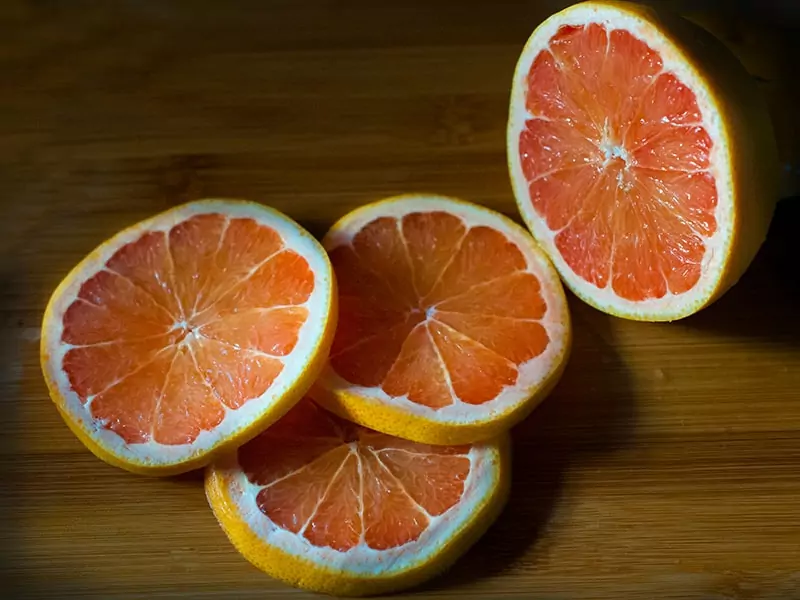
It is straightforward to find different types of citrus fruit in Cuba, but toronja or grapefruit is a name I want to show in this list. When you come to Varadero restaurants and resorts in Cuba, you will catch this fruit easily.
This citrus fruit is a hybrid fruit, and it is created from sweet orange and pomelo. It originated in Asia and gradually became famous globally. You will be impressed by the characteristic oblate spheroid shape of this fruit.
Almost all grapefruit is deep green. After peeling the glossy rind, the white, pink, or red flesh with many segments will appear in front of your eyes. Please remove the thin and bitter film before eating the sweet and juicy pulp.
There are various varieties of grapefruit, and Texas and Florida grapefruit are the 2 main varieties. Grapefruit deserves to be a fantastic treat after each meal to refresh your palate. Also, you can squeeze it to get juice or prepare fresh salads.
Nutrients: High in calories, carbs, fiber, vitamin C, A, thiamin, and potassium.
Season: August to December is the best time for harvesting grapefruit in Cuba.
How to eat: Let’s start peeling the rind and separating the segments. Remove the thin film around the pulp before eating.
12. Custard Apple – Cherimoya
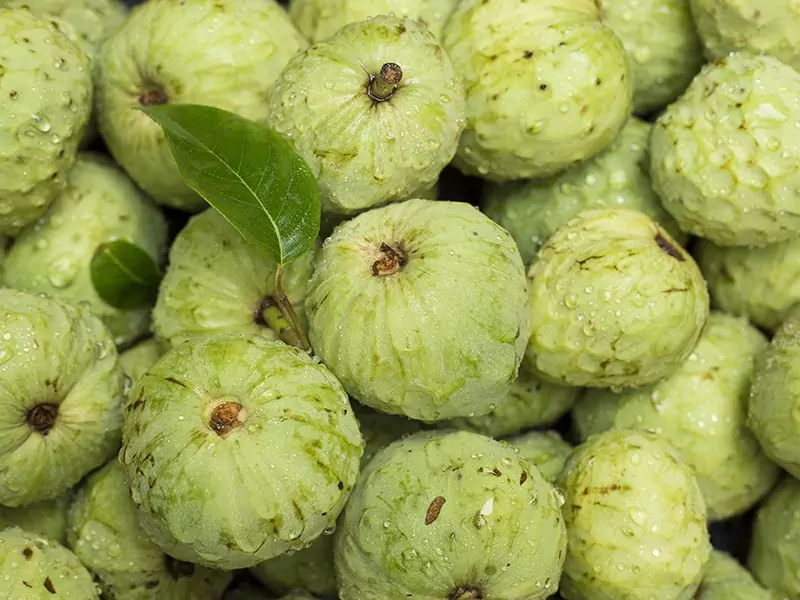
Custard apple or cherimoya originates in South America and is one of the famous Peruvian fruits. Also, it is loved by many people in Cuba and other countries in the Americas. It is easier to find this fantastic fruit in the rural areas of Cuba.
It is a member of the Annonaceae family along with guanabana. Inca people often call this fruit chirimuya. It is described as “the yummiest fruit known to men” by an American writer. The English name “custard apple” comes from its creamy texture.
Thanks to this delicious fruit’s heart shape and green skin, you can recognize cherimoya easily. There are many overlapping scales on the surface of the skin. When ripe, the brown color and a fissured texture will be the dominant features of its appearance.
The white and creamy flesh is suitable for making smoothies or eating raw. This fruit has many tiny black seeds inside. The custard apple recipes will have a sweet taste and a bit of tartness. Significantly, this fruit has a characteristic fragrance.
Nutrients: Plenty of protein, fiber, carbs, calories, vitamin C, and phosphorus.
Season: The season lasts from July to August in Cuba.
How to eat: When ripe, this fruit is soft. Therefore, you can break it with your hand. Consume the flesh with a spoon. Do not forget to remove the seeds.
It is time to explore all the essential things about custard apples.
13. Starfruit – Carambola
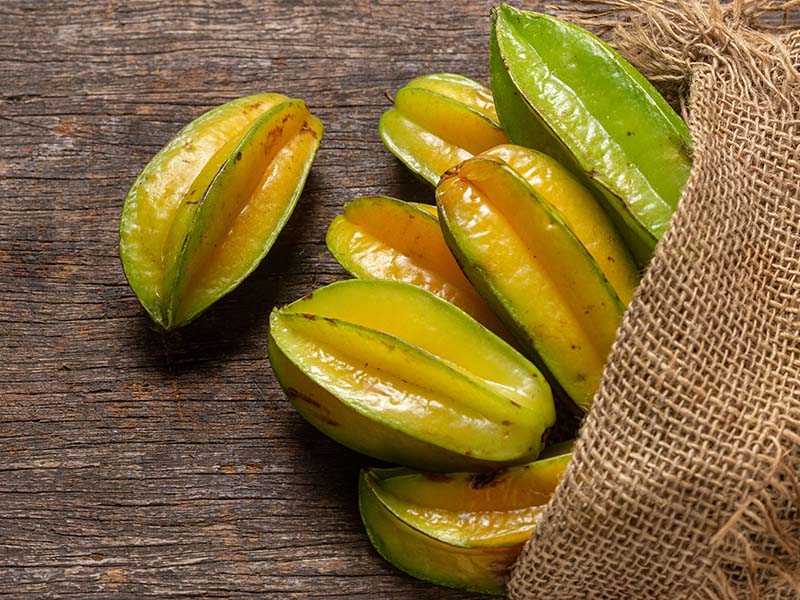
It is a pity not to mention starfruit or carambola in this Cuban fruits list. The tropical fruit is native to Southeast Asia, and it is also cultivated commonly in Cuba, Brazil, the Caribbean, the US, and other tropical parts.
I love its appearance because it is unique. It has 5 ridges along the sides and creates star shapes when cutting vertically. Therefore, it is a common choice for garnish in cuisine. It is possible to eat this excellent fruit’s waxy and glossy rind.
Moreover, eating the whole succulent fruit from the skin to the seeds is acceptable. You can try 2 different groups of starfruit, including small sour and large sweet types. Both have a sweet and sour taste, but the large sweet variety will be sweeter due to the low acid content.
Starfruit contains many helpful nutrients that are good for anti-inflammatory and weight loss. In Cuba, you can find its flavor in juices, cocktails, salads, alcoholic drinks, and many dishes as decorative accessories.
Nutrients: Add fiber, vitamin C, B5, folate, copper, potassium, and magnesium to your body.
Season: In Cuba, you can buy it easily from late winter to spring.
How to eat: There is no problem eating the whole fruit after washing.
14. Cacao
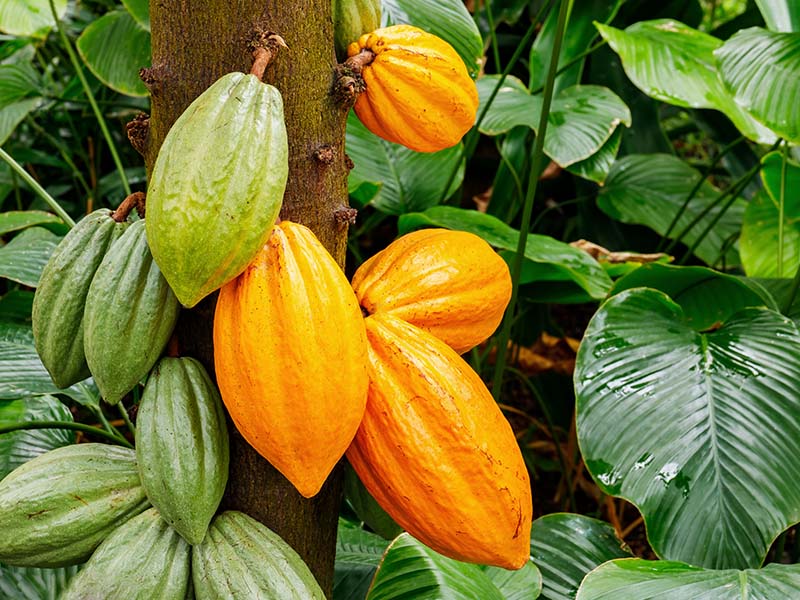
Cacao is one of the iconic fruits of America. This fruit belongs to the Malvaceae family and is the main ingredient in making outstanding chocolate that you often use as a gift for your lover on Valentine’s Day.
Southeastern Mexico and the Amazon basin are the places that cultivate the most cacao. But, Ivory Coast is the leading producer of cacao worldwide. People often call this fruit “cacao pod” because it has an oval pod outside.
You can see the cacao trees with many yellow or orange fruits in the peak cacao season in Cuba. The white and edible pulp will surround 20 to 60 seeds. People will use its seeds to make chocolate.
Meanwhile, the pulp is ordinary in juices, creams, jellies, and smoothies. In addition, Cubans often ferment the pulp and distill the liquid to prepare the alcoholic beverage.
Nutrients: Rich in calories, protein, carbs, fiber, and potassium.
Season: The best time for harvesting cacao in Cuba is between October and February.
How to eat: Break the pod of this fruit and consume the pulp around the seeds. Toast the seeds to make chocolate.
15. Seagrape – Uva Caleta
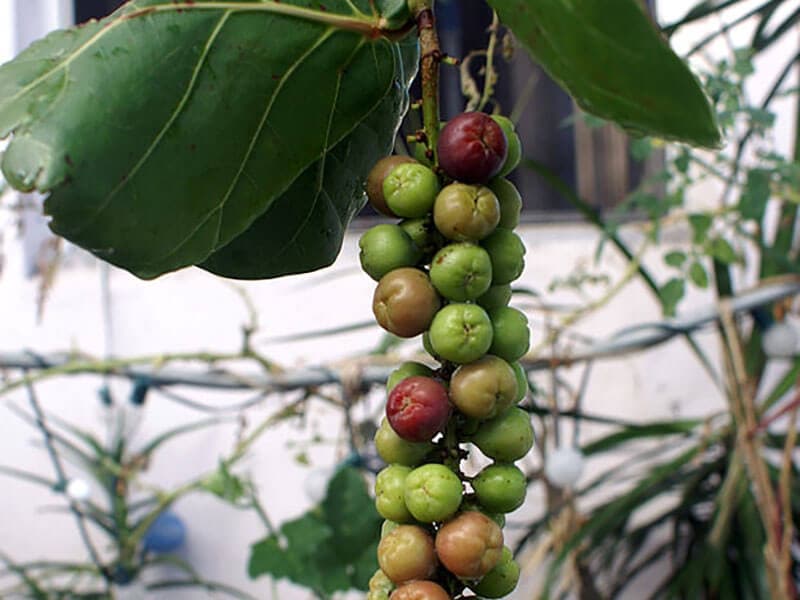
In English-speaking countries, people call it seagrape or baygrape. This fruit is grown commonly on coastal beaches in the Caribbean and America. In Cuba, you can find this fruit at the Havana beaches.
Uva Caleta’s appearance is similar to a grape with a round shape and small size. When mature, it is purple, and the juicy flesh will make you flutter while eating. There is a large pit in the center of the seagrape.
There are many ways to use seagrape in cuisine. Commonly, people will consume this fruit as a fresh fruit dessert. In addition, the flavor of seagrape jellies or jams is appealing. Cubans usually ferment this fruit to make excellent wine.
Nutrients: A source of calcium, iron, magnesium, vitamin C, protein, zinc, and polyunsaturated fatty acid.
Season: This fruit is available all year round in Cuba.
How to eat: Consume the flesh around the pit of the fruit.
Learn all the interesting facts about fantastic seagrape right now.
16. Star Apple – Caimito
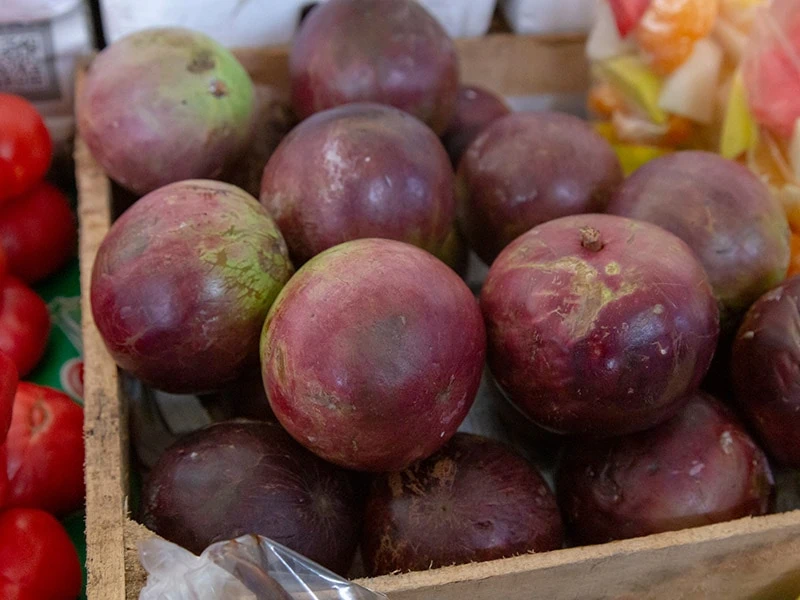
When speaking of the famous Cuban fruits, it is necessary to mention Caimito or star apple. Initially, it had its origin in the Isthmus of Panama and spread to the West Indies, Southeast Asia, and the Greater Antilles.
Besides these names, you can call it tar apple, purple apple, abiaba, or milk fruit. It is simple to buy this fruit at the local markets in Havana, Cuba. This fruit looks eye-catching in purple or green skin.
It got the name “star apples” because you can see a star image in the yellow or greenish-white pulp. You have to discard the brown and hard seeds inside the fruit. The pulp is really sweet and delicious.
Its flavor will remind me of the taste of sweet grapes and persimmon. You can consume raw Caimito as a sweet and yummy dessert. In addition, the juicy flesh is suitable for making juices and smoothies.
Nutrients: A rich source of fiber, vitamin C, B5, folate, copper, magnesium, and potassium.
Season: The peak season of this fruit is in March.
How to eat: To eat a star apple, you just need to slice it into 2 halves and scoop the flesh with a spoon.
17. Otaheite Apple – Manzana Pera
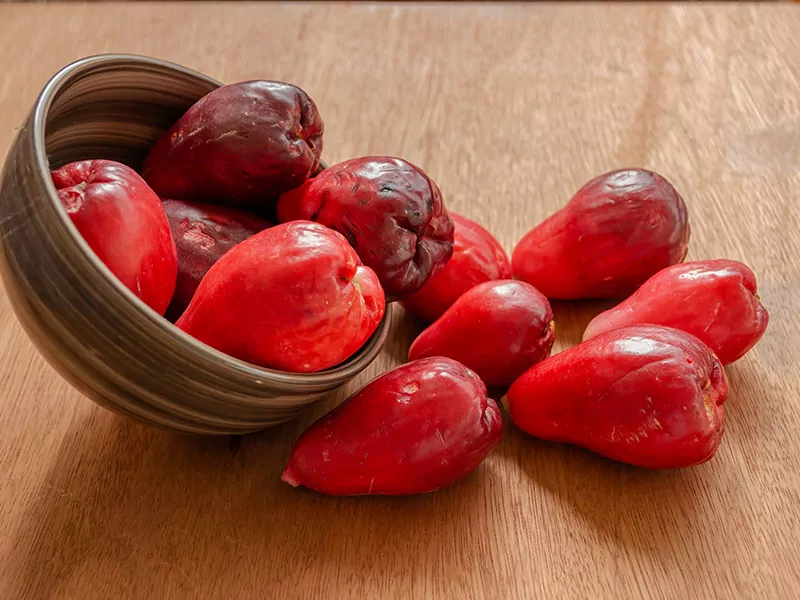
Although Manzana Pera appears abundantly in Cuba, people do not consume it regularly. Therefore, you can come across many rotten Otaheite apples on the ground. Cubans call it “starvation fruit” because they only eat it when they need it.
However, it is still a popular fruit in Cuba, so I have to add it. Manzana Pera means apple-pear in English. This fruit is native to the mountains of Jamaica and Hawaii. In Cuba, this fruit is widespread in Trinidad and Topes de Collantes.
Thanks to the distinctively smooth, deep red, or rosy colors, you can acknowledge this fruit. Occasionally, you can see the purple shade. A white pulp will cover an egg yolk-like seed. It has a delicate flavor with sweetness and a bit of tangy flavor.
Nutrients: It includes calcium, iron, vitamin A, B, C, fiber, flavonols, phosphorus, and carotenoids.
Season: Its season extends from August to September in Cuba.
How to eat: Remove the seeds of the fruit and chop them into small pieces to consume.
Let’s try an Otaheite apple to understand more about its taste.
18. Passion Fruit – Maracuya
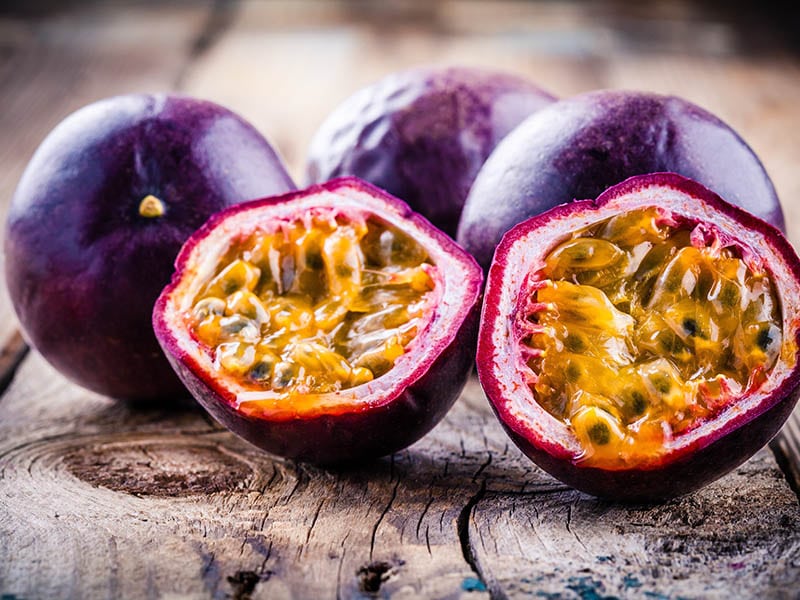
Passion fruit is a standard option if you search for a Cuban fruit that appears in many excellent Cuban drinks. Brazil, Argentina, and Paraguay are the well-known homelands of this juicy fruit.
Furthermore, you can enjoy it in Southeast Asia and many other subtropical and tropical regions worldwide. It is round and oval. You will be attracted by the glossy and purple skin of passion fruit.
People will use the seeds surrounded by succulent pulps to make outstanding juices, cocktails, and other drinks. There are many different types of passion fruit, including purple passion fruit, sweet granadilla, yellow passion fruit, and giant granadilla.
Almost all the drinks and foods that contain passion fruit will have the characteristic sweetness. Mainly, this fruit tastes like kiwi and pineapple with a bit of tartness.
Nutrients: High in vitamin C, A, iron, potassium, and calories.
Season: This fantastic fruit is ripe from summer to winter.
How to eat: Dice this fruit into 2 sections and get the juicy flesh and seeds using a spoon.
19. Banana
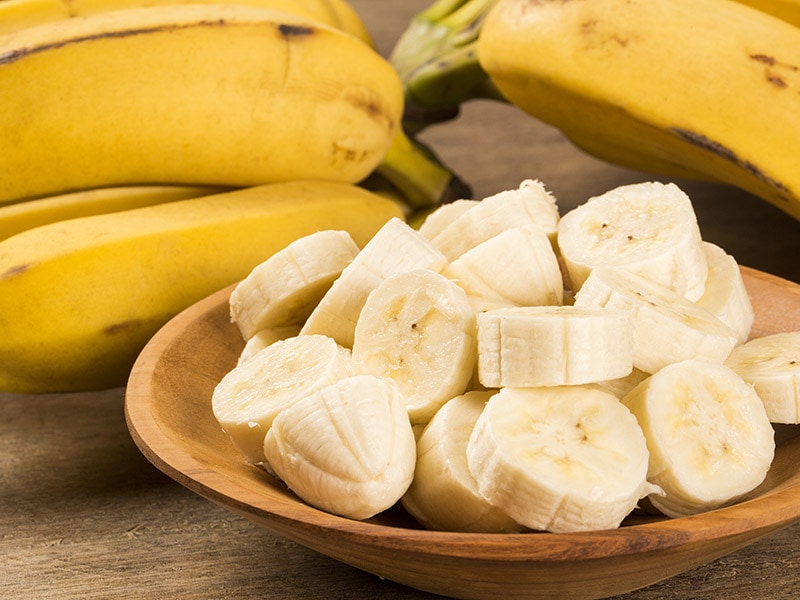
Banana is an indispensable part of each Cubans’ meal because it is a healthy fruit with many valuable nutrients. Banana is planted commonly in many tropical and subtropical nations worldwide. Its cultivation has occurred for the first time in New Guinea.
When ripe, the banana will give off an appealing scent. Typically, a ripe banana looks attractive in its pale yellow color. You need to remove the soft skin before consuming the creamy and aromatic flesh.
Bananas often grow in length, and you can consume the tiny seeds inside without worrying. This fruit is diverse in variety, with a lot of banana species found worldwide. Cuban has a distinctive combination that is called “baby banana”.
This type is sweeter than the standard varieties. Plantain is a green version of the banana, and it is used commonly in cooking. Cubans will eat fresh bananas after each meal. In addition, they make smoothies, pies, and fried bananas.
Nutrients: Plenty of calories, water, carbs, fiber, magnesium, and vitamin C, A.
Season: You can buy this delicious fruit all year round in Cuba.
How to eat: The simple way to eat a banana is to peel the rind and eat the creamy flesh.
20. Camu Camu
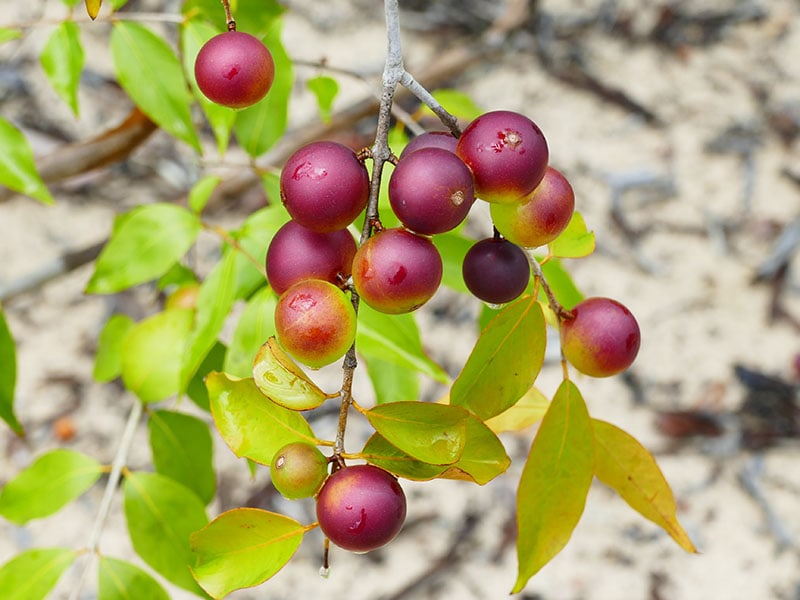
Camu Camu is a well-known South American fruit; you should give it a shot. This fruit originates in the rainforest in Brazil and Peru. It belongs to the Myrtaceae family and looks like a red or purple cherry.
It is small in size and turns a purple-black hue when ripe. The juicy flesh of Camu Camu fruit will bring sweetness to you. Significantly, a hint of acidity will stimulate your taste buds immediately. This fruit is a rich source of vitamin C.
The juiciness of the flesh is compatible with adding to drinks and juices, but you should use sugar to reduce the sourness of this fruit. Sometimes, you can find its taste in ice cream and other yummy desserts.
Nutrients: Rich in vitamin C, potassium, calories, iron, and magnesium.
Season: Its season runs from October to November and from February to June.
How to eat: Break the skin with your fingers and suck the flesh inside. Remember to discard the seeds while eating.
Change Your Palate With Other Cuban Fruits
After tasting these fruits I have introduced in the above sections, you can change your palate with the alternative Cuban fruits in this part. Their taste will make you fall in love immediately.
21. Pineapple – Pina
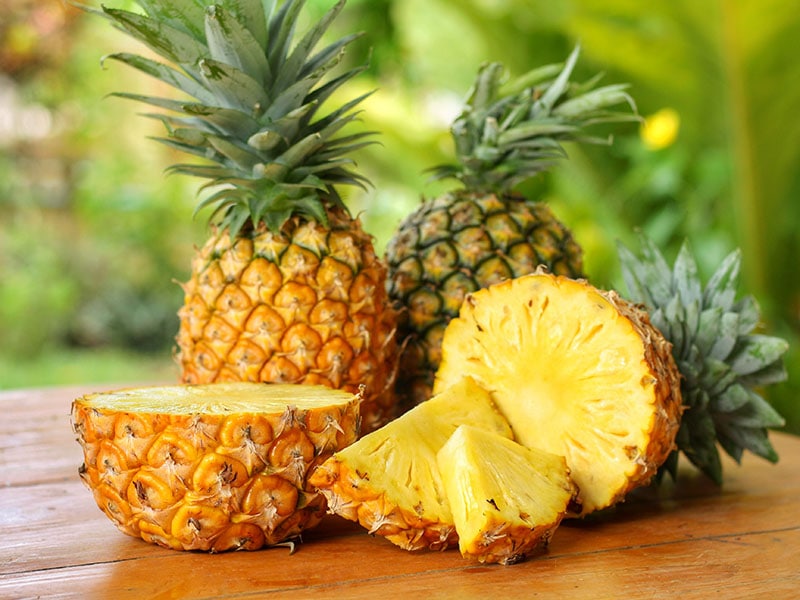
Pineapple is a representative of the Bromeliaceae family. This particular fruit is derived in South America and spreads gradually across the continent. In Cuba, it is rare to be found in the urban regions. Ciego de Avila and other provinces have many pineapples in Cuba.
You can imagine numerous eyes on the pineapple’s surface when you look at its appearance because there are many hexagonal units on the skin. After removing the rind, you can enjoy the juiciness of yellow or white flesh.
When you eat raw pineapple or try pineapple juice, you will be addicted to the enchanting sweetness. Furthermore, tartness is another dominant characteristic of this fruit. It has a high water content of about 86 percent. So, it is a good choice for cocktails and frozen daiquiri.
You should go to Paladar Don Omar to try the outstanding dish made from pineapple and Camaguey pork. This dish is named the Camaguey city in Cuba because most people in this city love the combination of pork and pineapple in this recipe.
Nutrients: High in calories, sodium, carbs, fiber, protein, vitamin C, and magnesium.
Season: Its season lasts from November to May in Cuba.
How to eat: Peel the skin with a knife and cut it into small pieces to eat.
22. Coconut
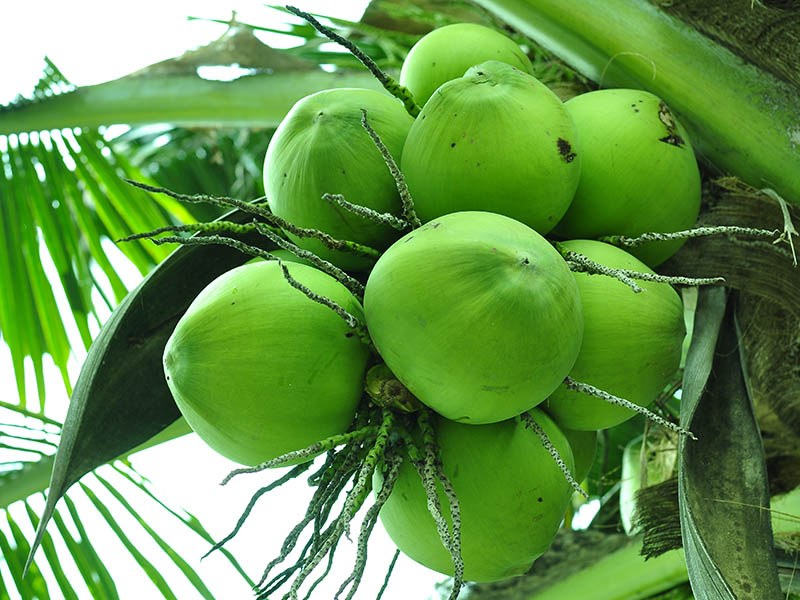
Until now, I still cannot forget the exciting feeling when drinking fresh and cooked coconut water on Havana beach. Coconut is a famous summer fruit in Cuba. Coconut is a tropical fruit that exists in many regions globally.
The name “coconut” comes from the “coco” word, which means “skull” in Portuguese. This fruit has its origin in the Central Indo-Pacific. Gradually, its cultivation takes place in many areas worldwide.
Coconut is a drupe fruit that includes 3 layers. The exocarp is the glossy and green skin of coconut. Beneath the exocarp layer, you will see the thick fiber layer, and it is called mesocarp. The endocarp is the final layer of this fruit.
You will love to enjoy the sweet and delicate water in the middle of this fruit. Significantly, its white, creamy, and smooth pulp is suitable for use in cuisine. People often make coconut milk or oil from its pulp.
Primarily, you can eat raw pulp to enjoy the natural taste of coconut. Cubans often use its liquid for cooking curries, stews, and soups or adding to cocktails, drinks, and other sweet desserts.
Nutrients: Rich in calories, fat, carbs, copper, manganese, and fiber.
Season: It is available all year round in Cuba.
How to eat: Create a hole on one end of the fruit to get the water inside. Cut it into 2 parts and use a spoon to get the white flesh.
Expand your knowledge by learning about the growth stages of a coconut.
23. Breadfruit
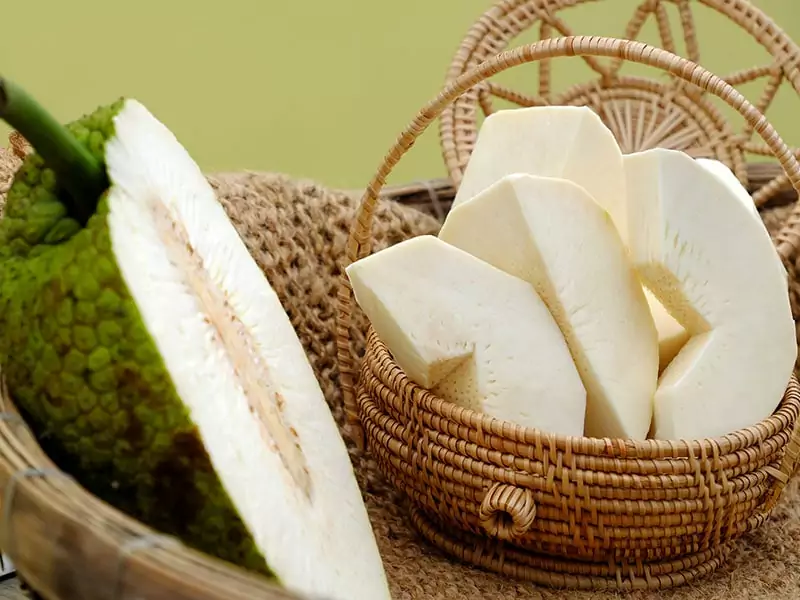
Breadfruit has a close relation with jackfruit and mulberry, so you can find many similarities between this fruit and jackfruit. This excellent fruit is derived from New Guinea, the Philippines, and the Maluku Islands.
You can choose the seeded or seedless varieties to consume. The seedless version was brought to the Caribbean and Central America in the 18th century. Its texture is similar to baked bread, so it gets the “breadfruit” name.
Like jackfruit, this fruit has oval, elliptical, or round shapes like jackfruit. When looking at the appearance, you can confuse it with jackfruit because it also has thick green skin with many tiny pimples on the surface.
The white flesh will show up when breaking the fruit. Its mild flavor can make you think of the taste of potatoes. The riper breadfruit will contain a high sugar content, so it will be sweeter. Cubans usually make roasted, boiled, fried, and baked foods from this fruit.
Nutrients: Sodium, carbs, fiber, protein, calories, and potassium.
Season: It is often ripe from July to February in Cuba.
How to eat: Break the fruit with your hand and eat the flesh inside.
Share Your Thoughts About These Cuban Fruits!
Besides getting a helpful list of yummy fruit, you will expand your knowledge with exciting information about Cuban fruits. It is a pity to miss any fruit on this list, so please try all of them if you can.
If you do not understand any information I have provided in this post, please leave your problems in the comment section. I will consider and solve them immediately. In addition, let’s share this post with your friends and relatives. Thanks a lot.
